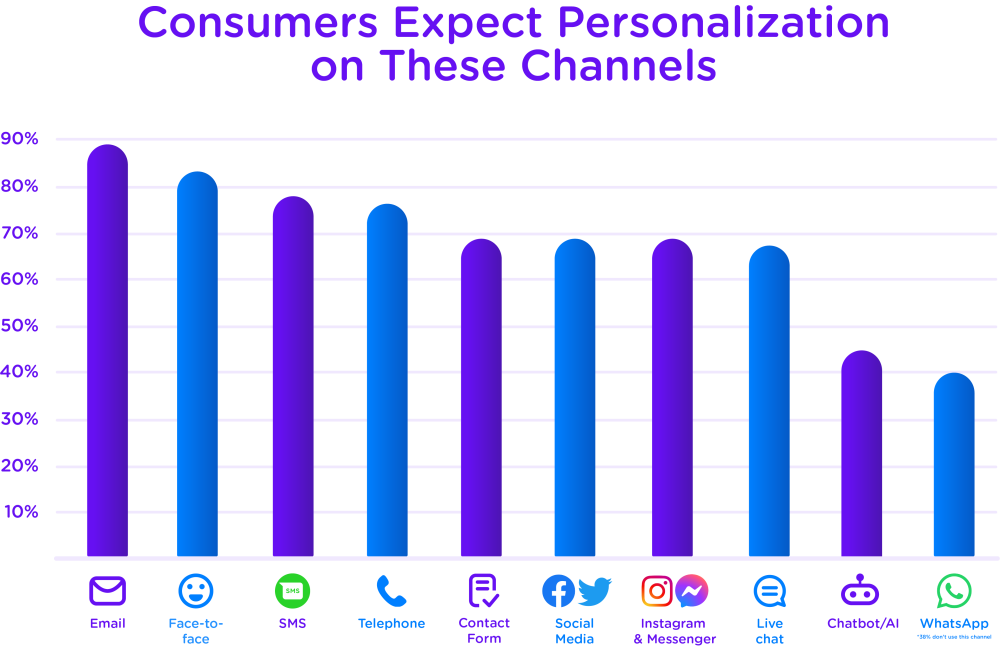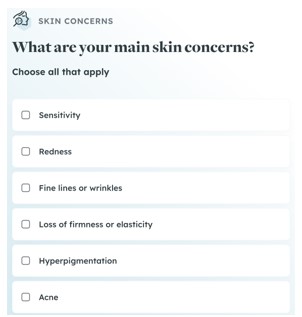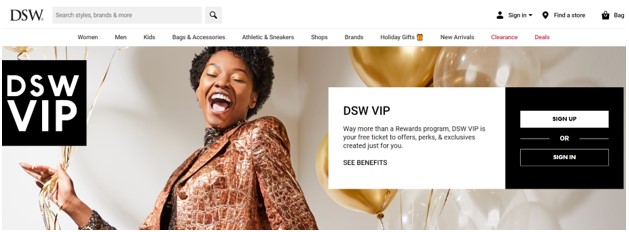Personalization is a strategic approach that tailors the shopping experience to individual customer preferences and behaviors. By harnessing data and employing cutting-edge AI technologies, retailers can offer customized product recommendations, personalized content, and targeted promotions. The result? A more engaged customer base, increased sales, and improved brand loyalty.
But there are major questions in the world of retail personalization, including implementation and consumer reaction. In fact, 37% of consumers say that they don’t want additional personalization in their shopping experience and find it unnecessary, while 64% believe it’s a critical aspect of the customer experience. Bridging this gap lies in retailers’ hands and how effectively they use it.
Let’s dive deeper into what retail personalization is and how you can use it to improve your small business.
What Is Retail Personalization?
Retail personalization is when retail businesses use AI technology to collect and analyze user data in order to tailor the shopping experience to individual customer preferences and behaviors. Retail personalization includes things like offering customized product recommendations, content, and promotions with the goal of boosting customer satisfaction and conversion rates, increasing engagement, driving sales, and fostering a deeper connection with your customers.
Many refer to the four Rs of personalization:
- Recognize your customers and who they are
- Remember returning customers
- Recommend things based on what you know about them
- (Be) relevant and offer tailored recommendations and interactions
If adopting AI technology is out of the question and you need to take on personalization efforts manually, small businesses can use purchase history, demographic info, and online behavior to create personalized offers, emails, and website experiences.
Why Personalization in Retail Is Important
It’s important for businesses to create a personalized retail experience for their customers for a number of reasons. Personalization can:
- Boost sales: Brands that personalize their customer interactions actually experience more sales. In fact, those that successfully implement personalization earn 40% more revenue from those efforts than the average brand. And consumers say the same—84% believe personalization influences their purchases and 68% have bought an item they didn’t initially intend to based on personalized recommendations.
- Increase customer satisfaction: Lack of personalization can actually detract from the shopping experience and create a poor impression of your brand. According to research, 71% of consumers expect companies to deliver personalized interactions and 76% get frustrated when this doesn’t happen. A third of shoppers feel that companies are not meeting their expectations when it comes to personalization—around 37% of consumers are dissatisfied with the way companies communicate with and misunderstand them.
- Drives customer loyalty: A great shopping experience means customers are more likely to make future purchases. In fact, 88% actually say they’re more likely to continue shopping with retailers that make these efforts.
- Tap into customers’ willingness to share data: To get the personalized recommendations they want, consumers need to provide some of their information. And they’ll willingly do so—80% of consumers will share data in exchange for deals and offers relevant to them. Another survey found that 92% of consumers will share personal data if it means fashion brands will tailor and personalize a product. More specifically, 66% of consumers will share body measurements.
- Drive profit: Better experiences mean you can charge higher prices, which ultimately increases profit margins. In fact, consumers are willing to pay more for an improved shopping experience.
- Give You a competitive advantage: Despite companies’ confidence in their personalization efforts, they’re falling short. In fact, 71% of retailers think they do it well, but only 34% of consumers share that sentiment.
How to Implement Personalization in Retail
Implementing retail personalization requires effective data management, privacy considerations, and technology tools like customer relationship management (CRM) and point-of-sale (POS) systems. It’s essential for small businesses to strike a balance between personalization and privacy, ensuring customers feel valued without compromising their data security.
Personalization starts by gathering relevant data about your customers. This includes purchase history, browsing behavior, demographics, and any other data points that can provide insights into their preferences.
Too often, retailers don’t have enough data to offer relevant recommendations. This leads to impersonal interactions. In fact, more than half of customers have received irrelevant messages and notifications from retailers, and 40% feel undervalued as a result.
There are two main ways to implement personalization in retail: manually and automatically with AI technology. Let’s take a look:
Manual Implementation
While the following retail personalization strategies could be implemented by AI if you have the technology, you can also accomplish them manually:
- Send birthday greetings via email and SMS
- Notify customers of local-to-them promotions and events—like pop-ups or location-specific free shipping promos
- Implement dynamic website content that changes based on the user’s behavior—product recommendations, recently viewed items, and tailored content
- Segment your email and SMS lists based on your shopper profiles
AI Implementation
All this personalization might seem like a lot of work to do without the help of AI, but that’s where your CRM, POS, and automations come into play. Use CRM systems to manage and analyze customer data effectively. Your POS system is also an important data collection and management tool.
Using this data, you can start to build shopper profiles. Shopper profiles then help you group or segment your customers with others who share similar interests, characteristics, and preferences. More than half of consumers prefer retailers to personalize the shopping experience for groups of similar customers.
Rather than manually triggering personalized efforts, you can set up automations that trigger based on shopper behaviors, time or date (such as birthdays), and more.
- Recommend products based on a customer’s past purchases and browsing history
- Offer tailored guides in the form of on-site assistance to your visitors (quizzes, size, and style guides)
- Display recently viewed items
- Personalize product pages based on location
Here are some resources to help you through this process:
- How to Create a Customer Profile (+ Free Template & Examples)
- How to Create a Customer Persona in 5 Steps (+ Free Template)
Personalization in Retail Tips & Best Practices
When implementing your retail personalization strategy, always try to use customer names. Implement words like “you,” “your,” and “yours” to make communication feel more personal.
Here are some additional tips and best practices to keep in mind:
Leverage AI Technology
As many as 98% of retailers believe AI can improve their business, and updating, managing, and enriching customer databases is their top priority when it comes to AI use cases. Other than taking customer data about what they buy, how much they spend, and related information, and then predicting future behavior, AI can also identify patterns and automatically adapt to those patterns to provide personalized and data-driven product recommendations for cross-selling and upselling.
When it comes to in-store personalization, your associates have more mobile tools to help them assist customers in their shopping journey. Plus, your staff can make smart product recommendations at checkout in an attempt to upsell at the last minute.
Learn more with our guide to AI in Retail: Small Business Guide.
Be Transparent & Compliant
While customers are willing to share data, they’re only willing to do so if it means they get a better experience. So while you need to ensure you’re using their information effectively, it’s also important to be transparent and upfront about what you’re collecting and how you’re using it.
Additionally, there are many data privacy laws and regulations to abide by. The California Consumer Privacy Act (CCPA) and the E.U.’s General Data Protection Regulation (GDPR) are two sets of standards to comply with. Generally speaking, these types of regulations require businesses to obtain consent before collecting data, as well as implement measures to keep that information secure.
Asking for consent isn’t only compliant, it’s also what consumers expect. While 58% of consumers believe sharing data with companies is necessary for personalization, 87% want businesses to ask for their permission to collect personal data first. Another 28% have concerns in this area.
It’s also important not to collect too much personal data. As far as what customers are willing to actually share, research from Digital Commerce 360 and CM.com found the following:
- Gender
- The city they live in
- How much they’re willing to spend on an item
- Age
- Who they’re shopping for
- Shopping history at the retailer’s physical store
- Browsing history on the retailer’s digital channels
- Purchase history
- Shopping behavior
- Previous conversations
And they’re generally not likely to want to share the following:
- Annual household income
- Household size
- Browsing history at this retailer’s physical stores
- Race
- Sizes
- Style preferences
- Average spending price point
- Previous purchases
- Preferred color schemes
- Contact information
- Bank details
- Unshared data
- Household information
- Relationship status
- Contact history
- Personal hobbies

Most customers are hesitant to share data so you need to handle personalization efforts with transparency and compliance to ensure you don’t scare people away. (Source: CM.com)
If you’re open, honest, and compliant, you can ease a lot of these concerns and build meaningful relationships with your customers.
Get the Right POS
Your POS is a valuable tool when it comes to personalization in retail. This is where you can collect basic information including customer name, email, address, and purchase history. The best POS systems not only collect this information but also organize it and share it with other tools in your business. Over time, you can personalize automated campaigns through your POS, enabling your associates to access customer profiles at checkout or on a mobile POS (mPOS).
Related: 10 POS Trends & Technologies Shaping the Future of Retail
Use the Channels Your Customers Use
It can be tempting to adopt all the new technologies and channels available to small businesses, but don’t forget to keep your customer preferences in mind. In fact, a top frustration for 30% of shoppers is when brands want them to communicate on channels they don’t use.
So, which channels should you stick with? While this depends on your audience’s unique preferences, you can use the following as benchmarks. Or, give them the choice—30% of shoppers want to be able to choose which channels brands use to interact with them.

Personalization is making waves and becoming a consumer expectation, especially on the channels above. (Source: CM.com)
Always Analyze & Improve
Personalization isn’t about setting it and forgetting. Like with most things in your retail business, in order to maximize these efforts, you’ll need to do regular reporting and analysis to identify what’s working and what needs to be adjusted. A/B testing can help you test two theories side-by-side, for example. Automation can also help with reporting and forecasting.
It’s also important to stay updated on the latest retail trends and technologies that impact your personalization strategy. And don’t forget to ask your customers directly. Send surveys, read customer reviews, and act on the feedback.
3 Retail Personalization Examples
Let’s take a quick look at personalization examples in the retail world to give you an idea of what it looks like.
Sephora
Cosmetics retailer Sephora is widely praised for its personalization initiatives which span both ecommerce and in-store shopping experiences. Its latest implementation is PROVEN, Sephora’s own line of skincare products. The customer journey begins online with a skincare quiz, and the experience is extended both online and in stores.

Sephora uses surveys and AI tech to add retail personalization to their consumer journeys. (Source: PROVEN)
DSW
DSW is a shoe retailer with a robust online and in-person presence. It has successfully integrated the two channels to offer a consistent—and personalized—customer experience across touchpoints. It largely relies on its customer loyalty program to effectively tailor promotions and communications to each shopper.

DSW’s home page lets customers opt into a VIP rewards program with personalized offers. (Source: DSW)
Seea
Sustainable swimwear brand Seea personalizes a lot of its marketing and promotions. In the example below, the brand sent an email to let shoppers know about a price drop. It likely used abandoned cart or purchase history data to personalize the product recommendation.

Seea uses personalized promos based on each consumer journey to help drive sales. (Source: Alexandra Sheehan)
Frequently Asked Questions (FAQs)
Click through the questions below to get answers to some of your most frequently asked retail personalization questions.
Personalization is the act of tailoring your engagements with customers based on their preferences, interests, and characteristics. Segmentation is when you group customers together based on shared preferences, interests, and characteristics.
An example of personalization in retail is promoting umbrellas to customers who are located in a rainy location.
The four Rs of personalization are: recognize, remember, recommend, and (be) relevant.
The value of personalization in retail is that it improves the shopping experience which leads to stronger customer relationships, more customer loyalty, and increased sales.
Bottom Line
Whether you’re just starting your retail business or looking for ways to improve your existing one, personalization can unlock a lot of opportunities. Personalization is about recognizing, remembering, recommending, and staying relevant to your customers. With it, you can create a shopping experience that builds connections, fosters loyalty, and ultimately drives growth.